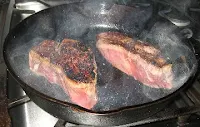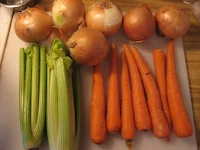 |
| Braised Short Ribs |
Tender, falling off the bone, full of meaty flavors with rich yet balanced aromas of red wine and hearty vegetables. Ahhh, the art of braising! Not an easy technique by any means, but when prepared properly, a braised item can be a very memorable dining experience. Cooking, by simple definition, is the application of heat to food. But all heat is not created equal. In the kitchen, there’s a big difference between moist heat and dry heat. Whenever you add a liquid to the pot or pan, for instance, when you simmer, boil, steam, or braise, you’re cooking with moist heat. If you don’t add a liquid when you sear, sauté, fry, roast, or grill, you’re cooking with dry heat. Braising is a very unique cooking method where you are actually cooking with dry
and moist heat. I’ll explain…

In order to achieve a great flavor profile of your braised item, it is important to sear the protein in a hot pan (
dry heat) in order to develop caramelization – browning flavor profiles-- and seal in the juices. Then by adding a liquid (
moist heat) and cooking at a low temperature for a longer period of time, the braised dish will be very tender and moist. This is definitely the best of both worlds as you benefit from all the spectrums of the cooking world!
 |
| Coq au Vin |
Once you have decided to experiment with braising, it is important to decide which cut of meat you wish to braise. Typically, braising is a very economical way to feed the family, as cheaper, underutilized and less tender cuts of meat are used. The slow and long cooking method allows the connective tissue and fat to break down much more, leaving those tougher cuts of meat melting in your mouth! Popular cuts of meat to braise include: shanks, brisket, flank, baby back ribs, short ribs, most cuts from the shoulder, arm and leg. These parts of the animal are exercised much more than others, which builds up and toughens the muscle, therefore it is necessary to break
 |
| Braising Meat |
that muscle down during the cooking process. The very popular Filet Mignon, is a much more tender cut of meat coming from the tenderloin and it is not necessary to braise it in order to tenderize, but of course it can be done. Don’t just stop with beef though, it is very common to braise poultry, pork, lamb, fish, and many vegetables a well.
Now that we’ve chosen the cut of meat, its time to develop those delicious flavors! Many popular braised dishes include Pot Roast, Beef Stew, Swiss steak, Coq au Vin, Chicken Cacciatore, Goulash, Braised Tilapia, Beef Bourguignon and Moroccan Tagine dishes.
(we'll be covering cooking in a Tagine in an upcoming installment) All of these popular dishes begin with important
 |
| Mirepoix |
ingredients; the item to be braised, vegetables, (
in most cases, Mirepoix; carrots, onions, celery), normally an alcohol such as a red or white wine, a flavorful liquid or stock (
water can be used), and aromatics. Once the item is seared and removed from the pot, flavor development begins with the caramelization of vegetables and with the addition of a tomato product. From here, you can deglaze with an alcohol and return the meat to the pot. Cover the item with the stock, about two thirds of the way up. Bring to a quick boil, then lower it to a simmer. Cover the pot with aluminum foil and place it in an oven for a few hours. Depending on the size and cut of the item, it can sometimes go for up to 8 hours.
 |
| Aromatics |
Aromatics play a very important role in braising. Fresh and dried herbs, spices, vegetables, and seasonings are all ways to enhance a braised item. They can be added all at once in the pot, or bunched up in a Sachet: a small cheesecloth bag, containing various herbs and spices, used to infuse flavor into stocks. These can typically include; bay leaf, thyme, parsley stems and black peppercorns.
How do we know when it's done? The terms "falling off the bone" or "fork tender" are great gauges of doneness. Remove the cover and test the product with a fork. If it is moist enough to fully pierce through with a fork, it is probably ready.
 |
| Pot Roast |
Now it's time to serve! We can ladle the braise or stew over mashed potatoes, rice, or vegetables, or choose to remove the meat and create a sauce with the left over braising liquid. All of those pronounced flavors will only get better when reduced down in a pot further to fully develop and concentrate.
There's really nothing to be afraid of and this is really not as hard as it sounds. Just take your time and like we've learned in prior installments of
The At Home Cook Series, just follow the steps. It's almost like a one pot meal, where presentation and knife skills are not nearly as important as the infusion of flavor from the cooking method. If you follow these easy steps to success, you are bound to create a very flavorful and palate appealing masterpiece!
Bon Appetit!
Lou

 In order to achieve a great flavor profile of your braised item, it is important to sear the protein in a hot pan (dry heat) in order to develop caramelization – browning flavor profiles-- and seal in the juices. Then by adding a liquid (moist heat) and cooking at a low temperature for a longer period of time, the braised dish will be very tender and moist. This is definitely the best of both worlds as you benefit from all the spectrums of the cooking world!
In order to achieve a great flavor profile of your braised item, it is important to sear the protein in a hot pan (dry heat) in order to develop caramelization – browning flavor profiles-- and seal in the juices. Then by adding a liquid (moist heat) and cooking at a low temperature for a longer period of time, the braised dish will be very tender and moist. This is definitely the best of both worlds as you benefit from all the spectrums of the cooking world!




